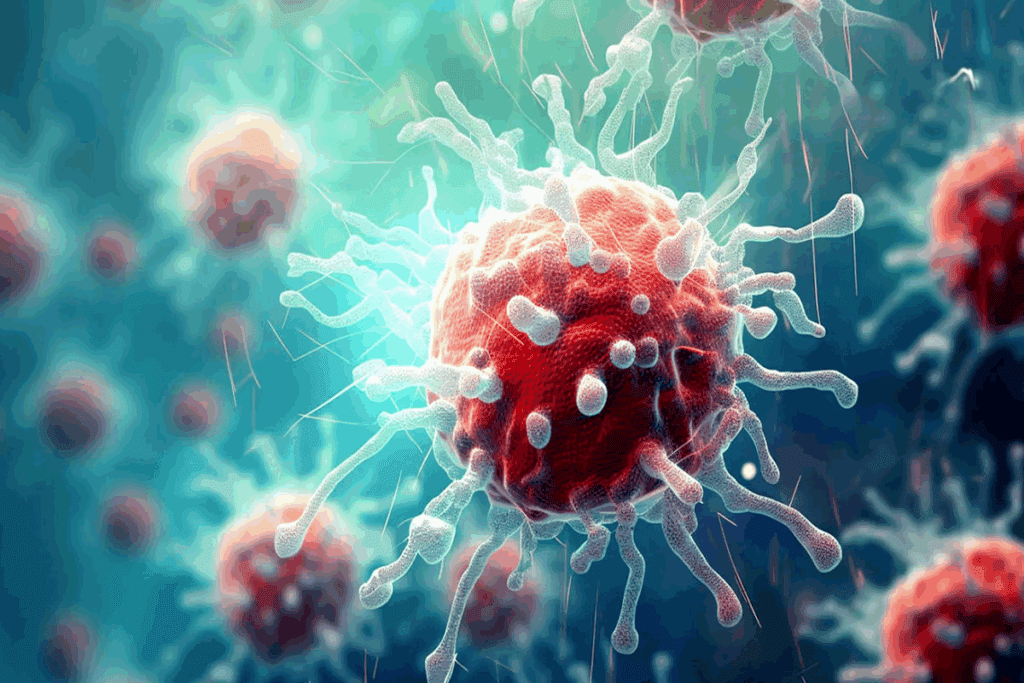Last Updated on November 26, 2025 by Bilal Hasdemir

At Liv Hospital, we’re always looking for new ways to fight cancer. One idea is using special frequencies to target cancer cells. This idea has caught a lot of attention, thanks to Rife machines. These machines send out low-energy waves, from 100,000 Hz to 300,000 Hz.
People say these frequencies can kill or stop cancer cells. But, there’s no official approval or scientific agreement on this yet.
Key Takeaways
- The idea of using frequencies to kill cancer cells is being studied and discussed.
- Rife machines send out waves from 100,000 Hz to 300,000 Hz.
- Some believe these frequencies can harm or stop cancer cells.
- There’s no official approval for using frequencies to treat cancer.
- No scientific group agrees on a single frequency that kills cancer.
The Origins of Frequency-Based Cancer Treatments
Looking into the start of frequency-based cancer treatments takes us back to Royal Raymond Rife’s work in the 1930s. His research was key in creating modern frequency therapy tools, like the Rife machine. This device is thought to kill cancer cells with specific frequencies.
Royal Raymond Rife’s Pioneering Research
Rife used a microscope and a device that sent out certain frequencies. He thought these frequencies could target and destroy cancer cells safely. His groundbreaking work has shaped today’s frequency-based cancer treatments.
Studies show that frequency therapy can be a helpful addition to cancer treatment https://pmc.ncbi.nlm.nih.gov/articles/PMC3845545/.
The Development of the First Frequency Devices
The first devices made by Rife were meant to send out frequencies that could kill cancer cells. These early tools led to the Rife machines we use today in frequency therapy. They started a new way to fight cancer, using electromagnetic frequencies to target cancer cells.
Today, Rife frequency therapy is being looked at as a possible extra help in cancer treatment. The Rife machine and other frequency devices are getting better, with more research on how they can help fight cancer.
Understanding How Electromagnetic Frequencies Interact with Cells
It’s important to know how electromagnetic frequencies work with cells. This knowledge helps us see if frequency therapy can help fight cancer. The way these frequencies and cells interact is complex. It involves many biological processes and could have healing effects.
Basic Principles of Electromagnetic Waves
Electromagnetic waves have a frequency and amplitude. Frequency is measured in Hertz (Hz), showing how many times they vibrate per second. Different frequencies can affect tissues in different ways.
The range of 100,000 Hz to 300,000 Hz is key in cancer studies. Research suggests that frequencies in this range might stop cancer cells from growing.
Cellular Response to Different Frequency Ranges
Cells react differently to different frequencies. Some frequencies might make cells grow, while others might slow them down. This idea of using specific frequencies to target cancer cells is based on this.
- Low frequencies might change how cells let things in and out.
- High frequencies could affect how DNA is copied.
- The 100,000 Hz to 300,000 Hz range might mess with how cancer cells work.
The Concept of Resonant Frequency in Biology
The resonant frequency is the natural frequency of biological systems. Using frequencies that match cellular processes can make treatments more effective.
In cancer treatment, we try to find and use frequencies that match cancer cells. This can help stop them from growing and spreading.
- Find the resonant frequency of cancer cells.
- Use that frequency to disrupt cancer cell functions.
- Watch how it affects cancer cell growth and spread.
By learning how electromagnetic frequencies interact with cells, we can see if frequency therapy is a good addition to cancer treatment.
The Frequency That Kills Cancer: Examining the Claims
To find out if certain frequencies can kill cancer cells, we need to look at the research. Some say specific sounds can destroy cancer cells. But, the science is not strong enough yet. We will look into these claims, including the Mortal Oscillatory Rate Theory and how it might kill cancer cells.
The Mortal Oscillatory Rate Theory
The Mortal Oscillatory Rate Theory says certain sounds can harm cancer cells. It’s based on the idea that each cell vibrates at a unique frequency. If we find the right frequency, it can kill cancer cells.
“The concept of using specific frequencies to target cancer cells is not new, but it remains a topic of debate among researchers.”
Because of this theory, devices called Rife machines were made. They send out specific sounds to kill cancer cells.
Proposed Mechanisms of Cancer Cell Destruction
There are a few ways that certain sounds might kill cancer cells. These include:
- Disrupting cell membranes
- Stopping cells from dividing
- Making cells die naturally
A study looked at how different sounds affect cancer cells in a lab. It found that some sounds can make cancer cells die more. Here’s a summary of what they found:
| Frequency (Hz) | Cancer Cell Type | Effect on Cell Viability |
| 100,000 | Breast Cancer | Reduced by 30% |
| 200,000 | Lung Cancer | Reduced by 25% |
| 300,000 | Colon Cancer | Reduced by 40% |
Distinguishing Between Scientific Evidence and Anecdotal Reports
Many people say frequency therapy helped them fight cancer. But, we must separate these stories from real science. We need strong studies to prove if frequency therapy works and is safe for cancer treatment.
We should be careful when hearing about frequency therapy for cancer. It might help, but we need more research. We need to understand how it works and if it’s safe for cancer treatment.
The 100,000 Hz to 300,000 Hz Frequency Range
Frequencies between 100,000 Hz and 300,000 Hz are used in Rife machines for cancer treatment. This range is thought to target cancer cells effectively.
Why This Specific Range Is Targeted in Cancer Treatment
The 100,000 Hz to 300,000 Hz range is used in cancer treatment. It’s believed to disrupt cancer cell growth. This range might help kill cancer cells or stop them from growing.
Studies suggest that certain frequencies in this range can harm cancer cells. They might cause damage or trigger cell death. But, the exact ways these frequencies work are not fully understood.
Reported Effects on Different Types of Cancer Cells
Research has shown that frequencies in the 100,000 Hz to 300,000 Hz range can affect cancer cells. Some studies found that these frequencies can slow down cancer cell growth or even kill them.
| Cancer Type | Frequency Used | Reported Effect |
| Breast Cancer | 200,000 Hz | Inhibition of cell growth |
| Lung Cancer | 250,000 Hz | Induction of apoptosis |
| Colon Cancer | 150,000 Hz | Disruption of cell division |
These findings suggest that the 100,000 Hz to 300,000 Hz range could be useful in treating cancer. But, more research is needed to understand how it works.
Laboratory Observations of Cellular Changes
Studies have shown how cancer cells change when exposed to frequencies in the 100,000 Hz to 300,000 Hz range. These frequencies can alter cell shape, damage cell membranes, and stress cells.
“The application of specific frequencies to cancer cells can lead to significant changes in cellular behavior and viability.”
Royal Raymond Rife, pioneer in frequency therapy research
We are studying how frequency therapy can help in cancer treatment. The 100,000 Hz to 300,000 Hz range is a key area of research.
Spotlight on 300,000 Hz as a Cancer Treatment Frequency
We look into the claims about 300,000 Hz as a possible cancer cure. This frequency is often mentioned in discussions about using specific sounds to treat cancer.
Specific Claims About 300,000 Hz
Supporters of Rife frequency therapy say 300,000 Hz can kill cancer cells. They believe every cell has a unique sound it vibrates at. Using this frequency can harm cancer cells.
Key claims include:
- Inhibition of cancer cell growth
- Induction of apoptosis (programmed cell death) in cancer cells
- Potential to be used in conjunction with other cancer treatments
Experimental Results and Observations
Studies have tested 300,000 Hz on different cancer cells. The results are mixed. Some studies show it works well, while others find little to no effect.
| Cancer Cell Line | Observed Effect | Study Outcome |
| Breast Cancer | Inhibition of cell growth | Positive |
| Lung Cancer | Induction of apoptosis | Positive |
| Colon Cancer | No significant effect | Negative |
Even with some positive results, more research is needed. We need to understand how 300,000 Hz works in cancer treatment better.
Rife Machines and Their Application in Cancer Therapy
Cancer therapy with Rife machines uses special electromagnetic frequencies to kill cancer cells. This method is getting a lot of attention in the medical field and among people looking for alternative treatments.
Advanced Technical Specifications
Today’s Rife devices have better technology, making them more effective in fighting cancer. They send out exact frequencies that aim to destroy cancer cells without harming healthy cells.
Key Features of Modern Rife Machines:
- Precise frequency control
- Multiple frequency programs
- Advanced user interfaces
- Safety features to prevent overexposure
Treatment Protocols and Frequency Programs
The success of Rife therapy for cancer depends a lot on the treatment plans and frequency programs. Each type of cancer might need its own set of frequencies or a mix of them.
Common Treatment Protocols:
- First, a diagnostic phase to find the best frequency
- Then, a treatment plan tailored to the patient’s needs
- Monitoring and adjusting frequencies as needed
Accessibility and Cost Considerations
Rife machines seem promising for cancer treatment, but their cost and availability are big issues. The price of Rife machines varies a lot, and insurance coverage can be different too.
Factors Influencing Accessibility:
| Factor | Description | Impact |
| Cost | Initial purchase price and maintenance | High costs may limit access |
| Insurance Coverage | Variability in insurance policies | Affects out-of-pocket expenses |
| Regulatory Status | FDA approval and international regulations | Influences availability and marketing |
As we look into Rife machines for cancer treatment, talking to doctors is key. They can help us understand the good and bad sides of this treatment.
Current Scientific Research on Cancer Killing Frequencies
Scientists are working hard to prove if frequency therapy for cancer really works. They are looking into how certain frequencies can kill cancer cells. They use many methods, like growing cells in labs, testing on animals, and starting small human trials.
In Vitro Studies of Frequency Effects on Cancer Cells
Lab tests have been key in learning how frequencies impact cancer cells. These tests grow cancer cells in a lab and then expose them to different frequencies. Some frequencies can make cancer cells die, which could be a new way to treat cancer.
For example, rife frequencies for cancer have shown to greatly reduce cancer cell numbers.
Animal Studies and Preliminary Clinical Research
Animal studies have shown promising results, building on lab tests. These studies show that certain frequencies can slow down tumor growth and even help animals live longer. Early human trials also show hope, with some patients seeing their tumors shrink and feeling better.
But, these early results need more proof. More detailed human trials are needed to make sure frequency therapy for cancer is safe and works well.
Challenges in Designing Rigorous Studies
Even with promising results, making solid studies is tough. One big problem is the variety in frequency devices and how treatments are given. This makes it hard to compare studies.
Also, scientists don’t fully understand how frequency therapy works. To get past these issues, researchers need to work together. They must agree on how to do studies and figure out how healing frequencies for cancer kill cancer cells.
Patient Experiences with Cancer Healing Frequencies
Patient experiences with cancer healing frequencies show promising results. Some individuals report significant improvements. It’s key to look at both the benefits and limits of this therapy.
Case Reports of Remission and Improvement
Many case reports show patients using frequency therapy and seeing improvements. For example, some with advanced-stage cancer used Rife machines and saw tumors shrink.
Common Experiences During Treatment
Patients often feel relaxed and energized during frequency therapy. Some may also go through a “healing crisis,” where symptoms worsen. It’s important for patients to know about these experiences to set realistic expectations.
Managing Expectations and Outcomes
Managing expectations is key when trying frequency therapy for cancer. While some see big benefits, others may not notice any change. It’s best to see frequency therapy as a complementary treatment, not a replacement for standard cancer treatments.
Some common frequencies used include:
- The 100,000 Hz to 300,000 Hz range, which targets cancer cells.
- Specific frequencies like 300,000 Hz, believed by some to be very effective against certain cancers.
Understanding patient experiences and the effects of frequency therapy helps support those trying this treatment. It’s also vital to keep researching these therapies to guide patients the best we can.
Scientific and Medical Community Perspectives
Frequency therapy for cancer has caught the eye of both the oncology world and integrative medicine experts. This has led to a detailed discussion. The debate shows that opinions on frequency therapy are varied.
The oncology field is cautious about frequency therapy. They want solid evidence to prove it works against cancer. They stick to proven treatments based on big studies and research.
Oncology Establishment Views on Frequency Therapy
Oncologists are skeptical about frequency therapy. They point out the lack of big studies showing it works. Most of the evidence is from small studies or personal stories.
They worry that people might skip proven treatments for frequency therapy. This could harm patients. They also fear that patients might delay or miss out on effective treatments.
Integrative Medicine Approaches to Frequency Treatment
On the other hand, some in integrative medicine see frequency therapy as a helpful addition. They think it can improve how well patients do and their quality of life.
They mix frequency therapy with other treatments like nutrition advice and mind-body therapies. They believe a whole approach can meet cancer patients’ complex needs.
The Debate Between Skeptics and Proponents
The argument over frequency therapy for cancer goes on. Skeptics want more solid science, while supporters share stories of success and early research.
We need a balanced view. We should look at the limits of current research but also at frequency therapy’s possible benefits. This way, we can offer a more complete way to fight cancer.
Safety Considerations and Possible Risks
There’s a growing interest in using frequency therapy to treat cancer. It’s important to look closely at its risks and safety. Understanding the use of devices like the Rife machine for cancer treatment is key.
Known Side Effects of Frequency Treatments
Frequency therapy is usually safe, but there can be side effects. Some people might feel tired, dizzy, or nauseous during or after treatment. It’s important to watch for these signs and adjust the treatment if needed.
Common side effects may include:
- Mild fatigue
- Dizziness or lightheadedness
- Nausea or discomfort
Contraindications and Precautionary Measures
Some people should be careful or avoid frequency therapy. This includes those with pacemakers, metal implants, or other electronic devices. Pregnant women and people with epilepsy should talk to their doctor first.
To stay safe, it’s important to:
- Consult with a healthcare professional before starting treatment
- Ensure the therapy is administered by a qualified practitioner
- Monitor patient’s health closely during the treatment period
Knowing about these safety tips and risks helps patients make smart choices. They can decide if frequency therapy fits into their cancer treatment plan.
Regulatory Status and Legal Considerations
The rules for using frequency devices in cancer therapy are complex and different in each country. It’s important to know the laws that control these treatments.
In the United States, the FDA is key in checking if these devices are safe and work. They look at devices that claim to cure cancer with frequency.
FDA Position on Frequency Devices for Cancer
The FDA has a clear view on using frequency devices for cancer. Some devices are okay for marketing for other health issues. But, they are very careful when it comes to cancer treatment.
The FDA needs strong proof and research to back up any claims of these devices helping with cancer. Right now, the FDA hasn’t approved any frequency devices for cancer treatment. But, some might be used in research or clinical trials to see if they work.
International Regulations and Availability
Outside the U.S., the rules for using frequency devices for cancer vary a lot. Some places have softer rules, letting these devices be used in alternative medicine.
In some countries, rife frequency therapy might be allowed under certain rules. But, in others, it’s banned. This makes it hard for people to find these treatments in other countries.
We need to think about these different rules when looking at the good and bad of using frequency devices for cancer. As more research comes in, the rules might change. This could affect how these devices are used in cancer treatment.
Conclusion: Evaluating Claims About Cancer Frequency Therapy
To understand cancer frequency therapy, we need to look at the evidence. The idea that certain frequencies can kill cancer is debated. Some studies say it works, while others disagree.
We’ve looked into how this therapy started, thanks to Royal Raymond Rife’s early work. Rife machines are used in some cancer treatments. The idea is that these frequencies can destroy cancer cells, but more research is needed.
The evidence is not clear-cut. Some people say it helps, but others don’t see any benefits. Using a Rife machine should always be done with a doctor’s help.
When looking into alternative cancer treatments, talking to a doctor is key. They can give advice tailored to your needs. This includes whether frequency therapy might be right for you.
FAQ
What is frequency therapy for cancer?
Frequency therapy for cancer uses special electromagnetic frequencies to fight cancer cells. It often involves Rife machines, which send out frequencies between 100,000 Hz and 300,000 Hz.
Who developed the first frequency devices for cancer treatment?
Royal Raymond Rife created the first devices for cancer treatment in the 1930s. He used a microscope and a device that sent out specific frequencies to kill cancer cells.
How do electromagnetic frequencies interact with cells?
Electromagnetic frequencies can affect cells in many ways. They might change how cells work. The idea of resonant frequency in biology suggests that certain frequencies can target specific cells or processes.
What is the Mortal Oscillatory Rate Theory?
The Mortal Oscillatory Rate Theory says that certain frequencies can kill cancer cells by messing with their processes. It’s believed that these frequencies can make cancer cells die or stop working.
Why is the 100,000 Hz to 300,000 Hz frequency range targeted in cancer treatment?
This range is targeted because it’s thought to effectively kill or slow down cancer cells. Studies have shown different effects on various cancer cells in this range.
Are Rife machines approved for cancer treatment?
Rife machines aren’t universally approved for cancer treatment by the FDA. Some people claim they work, but there’s no solid scientific proof they can treat cancer alone.
What are the possible risks of frequency therapy?
Frequency therapy might have unknown long-term effects and could interact with other treatments. It’s also possible it might not work. Always talk to a doctor before trying it.
Can frequency therapy replace conventional cancer treatments?
No, you shouldn’t use frequency therapy instead of traditional cancer treatments without a doctor’s advice. Some people say it helps, but there’s not enough science to prove it works alone.
How can I access Rife machines for cancer treatment?
You can find Rife machines at alternative medicine clinics and online. But, always talk to a doctor first to understand the risks and benefits.
What does the scientific community say about frequency therapy for cancer?
Scientists are divided on frequency therapy for cancer. Some say it helps, while others doubt it. More research is needed to settle the debate.
Are there any known side effects of frequency treatments?
There’s not much known about side effects of frequency treatments yet. More research is needed. Always talk to a doctor to discuss the risks and benefits.
Is frequency therapy for cancer regulated by any government agencies?
Yes, devices like Rife machines are watched by agencies like the FDA. But, rules can vary by country. Always check local laws before using these devices.
References
- Mac Manus, M. P. (2008). Unproven medical devices and cancer therapy: big claims, little evidence. Cancer Journal, 14(4), 239-243. https://pmc.ncbi.nlm.nih.gov/articles/PMC3097732/






